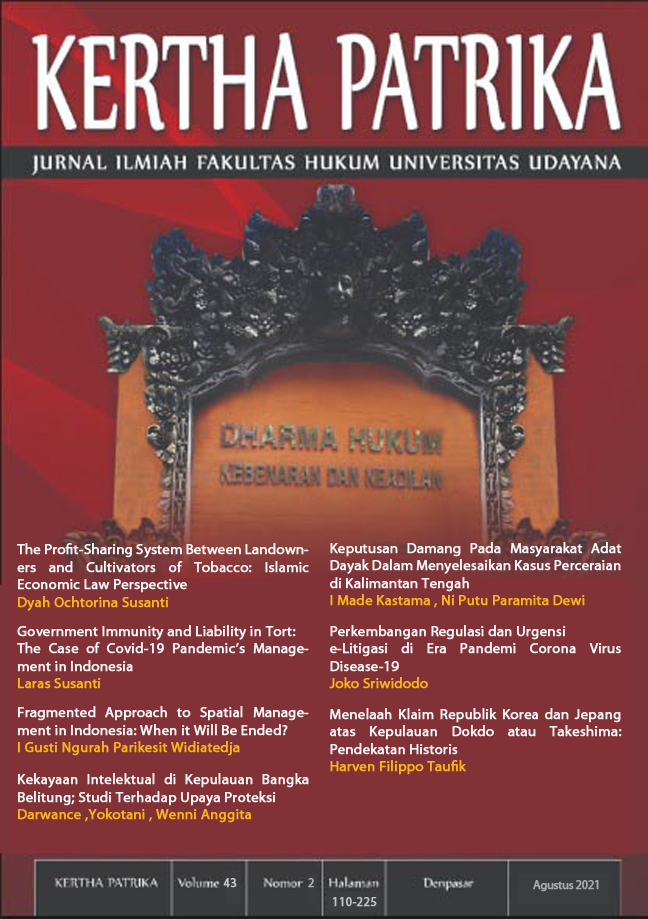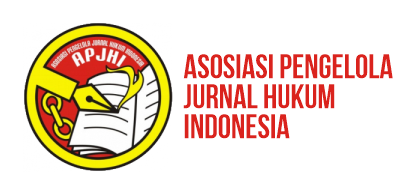Fragmented Approach to Spatial Management in Indonesia: When it Will Be Ended?
Abstract
As a regulatory tool, spatial planning is important as it directs socio-economic development and prevents environmental and social damage by commercial and public projects. There should be an integrated spatial management to ensure the effective use of restricted spatial resources, balancing infrastructural, industrial and commercial business development with the available resources, including land, forest, and marine. However, the fragmented approach to spatial management has been thrived since the independence of Indonesia. The newly controversial Law No. 11 of 2020 on Job Creation has emerged a big hope that Indonesia will end the fragmented approach to spatial management. However, this Law seems to maintain this approach by enacting four different governmental regulation for four spatial issues, namely land use planning; forestry; energy and mineral resources; and marine and fishery. This fragmented approach has adverse consequences as it leads to overlapping authorities that may end up with disharmony and conflicting regulations. Besides, the insistence to employ fragmented approach to spatial management has linked to oligarchy issue as shown by old older, new order and the regional autonomy era.
Downloads
References
Books
Baker, J. (2012). The Rise of Polri: Democratisation and the Political Economy of Security in Indonesia.London School of Economics and Political Science.
Butt, S. and Lindsey,T. (2018). Indonesian Law, Oxford: Oxford University Press
Fuller, L. (1969). The Morality of Law. New Haven: Yale University Press, 2nd revised ed.
Myrdal, G (1970). The Challenge of World Poverty: A World Anti-Poverty Programme in Outline. Penguin Books.
Morgan, B. and Yeung, K (2017). An Introduction to Law and Regulation: Text and Materials. Cambridge: Cambridge University Press.
Moeliono, T.P. (2011). Spatial Management in Indonesia: From Planning to Implementation, Cases from West Java and Bandung, A Socio-Legal Study. Universiteit Leiden
Nordholt,H.S. and Klinken,G.V. (eds).(2007). Renegotiating Boundaries: Local Politics in post-Soeharto Indonesia. Leiden: KITLV Press
Colombijn, F. et al (eds).(2005). Kota Lama Kota Baru, Sejarah Kota-Kota di Indonesia. Jakarta: Penerbit Ombak.
Sampe, S. (2015). Political Parties and Voter Mobilisation in Local Government Elections in Indonesia: the Case of Manado City. the University of Canberra.
Silas, J. (1989). Perjalanan Panjang Perumahan di Indonesia dalam dan Sekitar Abad XX. The Institute of Technology Bandung.
The United Nations Conference on Trade and Development (2015). Investment Policy Framework for Sustainable Development. Geneva: United Nations.
Journals
Allmendinger, P. and Haughton, G. (2013). The Evolution and Trajectories of Neoliberal Spatial Governance: Neoliberal Episodes. Planning, Practice and Research, 28(1), 6-26. DOI: https://doi.org/10.1080/02697459.2012.699223.
Aspinall, E. et al (2017). Vote Buying in Indonesia: Candidate Strategies, Market Logic and Effectiveness. Journal of East Asian Studies 17, 1-27, DOI:10.1017/jea.2016.31
Aspinall, E., and Mas’udi, W. (2017). The 2017 Pilkada (Local Elections) in Indonesia: Clientelism, Programmatic Politics and Social Networks. Contemporary Southeast Asia: A Journal of International and Strategic Affairs 3(3), 417-426, https://www.jstor.org/stable/44684048
Albrechts,L. (2006). Shifts in Strategic Spatial Planning? Some Evidence from Europe and Australia. Environment and Planning, 38(6), 1149-1170, DOI: https://doi.org/10.1068/a37304
Berenschot, W. (2018). The Political Economy of Clientelism: A Comparative Study of Indonesia’s Patronage Democracy. Comparative Political Studies 51(12), 1563-1593, https://doi.org/10.1177/0010414018758756
Healey, P. (1998). Collaborative Planning in a Stakeholder Society. The Town Planning Review, 69(1), 1-21, http://www.jstor.org/stable/40113774
Hull, A. (1998). Spatial Planning: The Development Plan as a Vehicle to Unlock Development Potential? Cities, 15(5), 327-335, DOI: https://doi.org/10.1016/S0264-2751(98)00028-6
Hudalah, D. and Woltjer, J. (2007). Spatial Planning System in Transitional Indonesia. International Planning Studies, 12(3),291-303. DOI: https://doi.org/10.1080/13563470701640176
McAuslan,P. (1981). The legal Environment of Planned Urban Growth. Public Administration and Development , 1, 301-317, DOI: https://doi.org/10.1002/pad.4230010406
Otto,J.M. and Syafrudin, S. (1990). Hukum Tata Ruang di Indonesia dan Belanda. Pro Justitia, 8(2), 5-28.
Scott,A.J. et al. (2013). Disintegrated Development at the Rural–Urban Fringe: Re-connecting Spatial Planning Theory and Practice. Progress in Planning, 83, 1-52 DOI: 10.1016/j.progress.2012.09.001
Taylor, N. (2010). What Is This Thing Called Spatial Planning? An Analysis of the British Government's View. The Town Planning Review, 81(2), 193-208. DOI: 10.3828/tpr.2009.26.
Valk, A.V.D. (2002). The Dutch Planning Experience. Landscape and Urban Planning, 58(2-4), 201-210, DOI: 10.1016/S0169-2046(01)00221-3
Wekwete, K.H. (1995). Planning Law in Sub-Saharan Africa: A Focus on the Experiences in Southern and Eastern Africa. Habitat International, 19(1) 13-28.
Wei-Ju, H. and Maldonado, A.M.F. (2016). High-tech Development and Spatial Planning: Comparing the Netherlands and Taiwan from an Institutional Perspective. European Planning Studies , 24(9), 1662-1683. DOI:https://doi.org/10.1080/09654313.2016.1187717
Online
Australian Government Department of Foreign Affairs and Trade. Renville Agreement. Available From https://dfat.gov.au/about-us/publications/historical-documents/Pages/volume-13/22-renville-agreement.aspx (Accessed on 17 January 2021).
Bali Mangrove Bay is Now a Conservation Zone, Nixing Reclamation Plan, Mongabay, 11 October 2019, available from https://news.mongabay.com/2019/10/bali-benoa-bay-mangroves-conservation-reclamation/ (Acessed on 17 February 2021).
Dili tycoon deal triggers alarm, the Sidney Morning Herald, 3 May 2009. Available from https://www.smh.com.au/world/dili-tycoon-deal-triggers-alarm-20090502-aqtj.html (Accessed on 23 February 2021).
Deborah Cassrels, The businessman who aims to turn Bali into the new Palm Islands, Financial Review, 9 September 2016. Available from https://www.afr.com/lifestyle/anguish-bali-tourist-development--and-the-enigmatic-tomy-winata-20160829-gr3v4r (Accessed on 17 February 2021).
Laws and Regulations
Undang-Undang No. 5 Tahun 1960 tentang Peraturan Dasar Pokok-Pokok Agraria
Undang-Undang Republik Indonesia Nomor 24 Tahun 1992 Tentang Penataan Ruang.
Undang-Undang Nomor 26 Tahun 2007 Tentang Penataan Ruang.
Undang-Undang Republik Indonesia Nomor 41 Tahun 1999 Tentang Kehutanan.
Undang-Undang Republik Indonesia Nomor 27 Tahun 2007 Tentang Pengelolaan Wilayah Pesisir dan Pulau-Pulau Kecil.
Undang-Undang Republik Indonesia Nomor 12 Tahun 2011 Tentang Pembentukan Peraturan Perundang-Undangan
Peraturan Pemerintah Republik Indonesia Nomor 36 tahun 2010 tentang Pengusahaan Pariwisata Alam di Suaka Margasatwa, Taman Nasional, Taman Hutan Raya, dan Taman Wisata Alam.
Peraturan Pemerintah Republik Indonesia Nomor 28 Tahun 2011 Tentang Pengelolaan Kawasan Suaka Alam dan Kawasan Pelestarian Alam.
Keputusan Menteri Kelautan dan Perikanan Republik Indonesia No. 46/kepmen-kp/2019 tentang Kawasan Konservasi Maritim Teluk Benoa di Perairan Provinsi Bali.
Court Decision
Keputusan Mahkamah Konstitusi No 137/PUU-XIII/2015.











